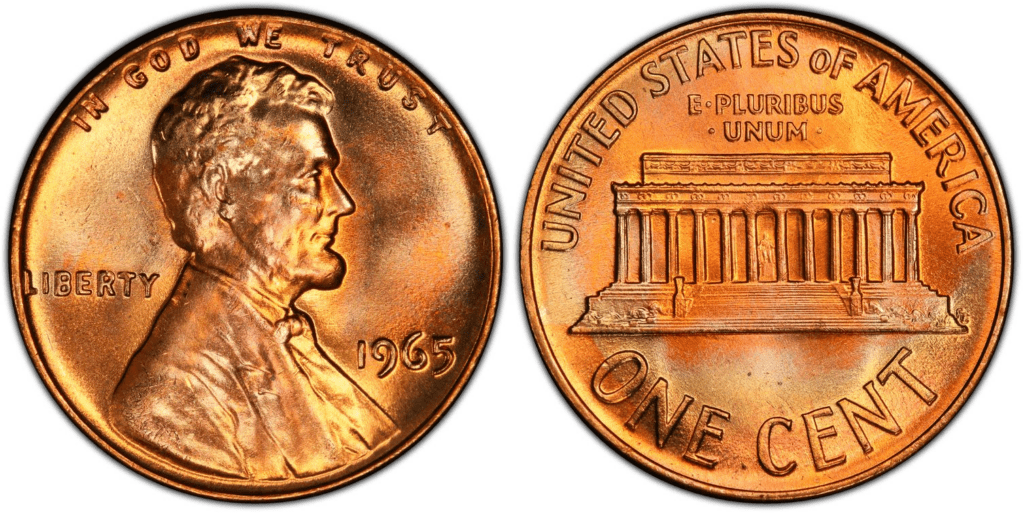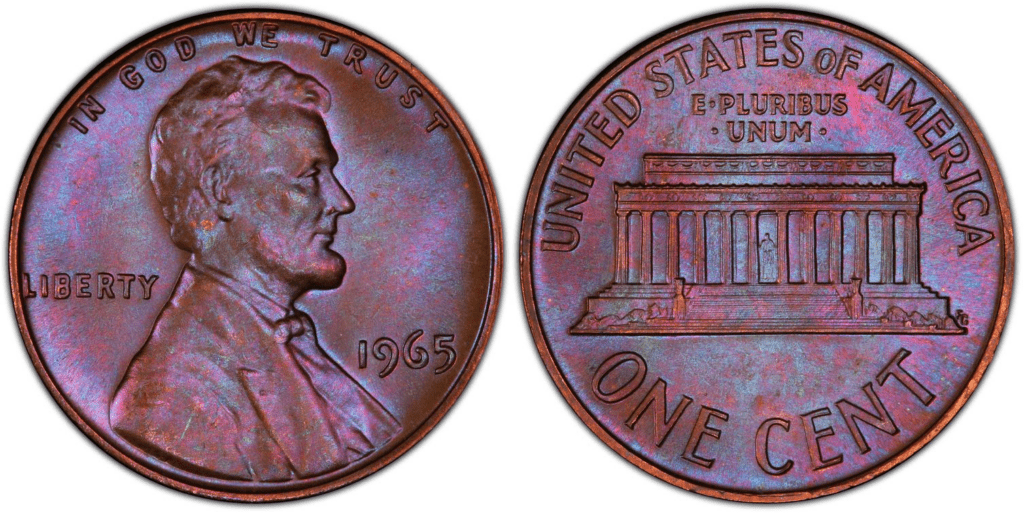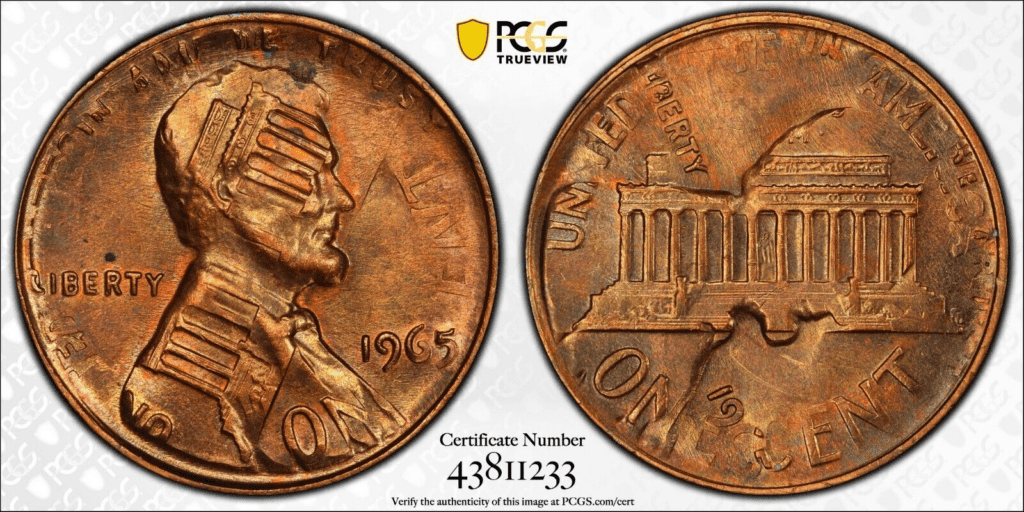The 1965 penny is one of the most interesting coins not just because of its value but also of its history. If you are looking for a new penny to add to your collection, consider the 1965 penny. Read this article and learn more about its composition, design, and availability.
What Is the 1965 Lincoln Penny Made Of?
The 1965 penny is part of the Lincoln series first struck in 1909. It has a value of one cent, a diameter of 19.05 millimeters, and a plain edge. The mass of the 1965 penny is 3.11 grams, heavier than the current mass of pennies, which is 2.5 grams.

When it comes to composition, the 1965 Lincoln has a core of 95% copper while it is plated with 5% zinc. The year 1965 is quite interesting in relation to US coinage. As you may remember, 1965 was the first year when the US Mint removed silver from all regular coins. As this might be the case, the composition of the Lincoln penny stayed the same since it didn’t have any silver in it.
Originally, the Lincoln penny had a wheat design for its reverse. At the time of its first release in 1909, the designer of both the obverse and reverse sides of the coin was Victor David Brenner. However, in 1959, the reverse design was changed to the Lincoln Memorial, which Frank Gasparro designed. In 2010, the reverse design was again changed with the Union Shield made by Lyndall Bass.
1965 Lincoln Penny Varieties
The 1965 Lincoln penny was exclusively produced in the Philadelphia Mint. Since this was the first year that the silver content of US coins was removed, there were a few adjustments that the US Mint needed to make.
Aside from the regular 1965 penny, there were also pennies with a special strike. Here’s what the mintage figures look like:
| Variety | Mint Location | Mintage |
| 1965 P Lincoln Penny | Philadelphia | 1,497,224,900 |
| 1965 P Special Strike Lincoln Penny | Philadelphia | 2,360,000 |
| Total | 1,499,584,900 |
With that, let’s take a deeper look at each of these varieties.
1965 P Lincoln Penny
Edge: Plain
Mint Mark: none
Place of minting: Philadelphia
Year of minting: 1965
Face Value: $0.10 (ten cents)
Price: $0.01 to $0.35 (circulated condition)
Quantity produced: 1,497,224,900
Designer: Victor David Brenner (obverse)/Frank Gasparro (reverse)
Composition: 95% copper, 5% zinc
Mass: 3.11 grams
Diameter: 19.00 millimeters

1965 the Philadelphia Mint Center was the only mint that produced the Lincoln penny. As the country’s first mint, the Philadelphia Mint had the necessary equipment to produce the pennies. The mint produced almost 1.5 billion pennies in 1965.
As impressive as it may sound, this mintage figure is low compared to the previous and following years. In 1966, the Philadelphia Mint would still be the only mint center producing the Lincoln cent, but its production rose to 2 billion pennies.
If you plan to collect a 1965 penny, you should easily find it in a circulated condition. However, the 1965 penny becomes somewhat scarce when it reaches a grade of MS 66. Anything above this grade can be difficult to find.
1965 P Special Strike Lincoln Penny
Edge: Plain
Mint Mark: none
Place of minting: Philadelphia
Year of minting: 1965
Face Value: $0.10 (ten cents)
Price: $3 to $8 or more (mint condition)
Quantity produced: 2,360,000
Designer: Victor David Brenner (obverse)/Frank Gasparro (reverse)
Composition: 95% copper, 5% zinc
Mass: 3.11 grams
Diameter: 19.00 millimeters

If you’re looking for 1965 proof pennies, you won’t find any because the Philadelphia Mint didn’t release proof pennies from 1965 up to 1967. However, they replaced the proof coins with the Special Mint Sets. This was done to discourage the public from hoarding the coins.
The Lincoln Penny Special Mint Set was made with special care by the Philadelphia Mint. It has a nicer finish, a brighter surface, and a more detailed look. The US Mint used special planchets and dies to make these coins.
The special set wasn’t meant for circulation but is sold by the US Mint in special packaging. Thus, you should find special sets that are more beautiful and well-preserved than the circulated 1965 pennies.
Because of how the special sets were produced, some examples exhibit Cameo and Deep Cameo characteristics. These examples are scarcer and would surely be more valuable than its other Lincoln penny counterparts.
List Of 1965 Lincoln Penny Errors
With more than a billion 1965 Lincoln pennies, it is not difficult to see that some of them were made with errors. Due to mechanical failure or, in some cases, human errors, coins can be improperly minted.
What’s interesting about error coins is that although they are made with errors, they can still be worth a lot of money. The reason is that they could potentially have unique and interesting characteristics.
Thus, you might be wondering what might be some examples of 1965 Lincoln pennies. In that case, you need to check out this list:
1965 Lincoln penny with “L” on the border

In this error, you’ll see that the letter “L” of the word LIBERTY is so close to the coin’s edge that it almost disappears.
Clipped planchet

A clipped planchet error happens during the cutting of the coin. Due to the misfeeding of the metal sheet, the machine cuts a portion of the previously cut coin, making the next coin have a clipped portion.
Flip over double struck mint error

A Lincoln penny was struck twice by two different dies on the same side. As you can see in the image above, Lincoln’s face is marked with the Lincoln Memorial. On the reverse, the Lincoln Memorial is distorted along with its inscriptions.
This is an extremely rare error; thus, it commands a high premium. On eBay, you’ll find an owner selling this coin for $2,492.
How Much Is the 1965 Lincoln Penny Worth Today?
The 1965 Lincoln penny isn’t worth a lot of money if you’re going to base it on the melt value and face value. The melt value is just $0.0273, and the face value is one cent. Circulated 1965 pennies aren’t much either, with their price hovering around $0.01 to $0.35.
Nevertheless, the true value of the 1965 Lincoln penny lies in its rarity and condition. If a 1965 Lincoln penny is rare and well-preserved simultaneously, it can be worth hundreds or thousands of dollars.
Take a look at this table of auction records to have a better idea of how much 1965 Lincoln pennies were sold for before:
| Coin | Condition | Grade | Sold date | Sold by | Value |
| 1965 P Lincoln Penny | Superb Gem Uncirculated | MS 67 (Red) | January 8, 2014 | Heritage Auctions | $7,638 |
| 1965 P Special Strike Lincoln Penny | Superb Gem Uncirculated | SP 68 – (Red) | February 1, 2009 | Heritage Auctions | $2,990 |
| 1965 P Special Strike Lincoln Penny | Superb Gem Uncirculated | SP 68 (Cameo) | September 3, 2018 | eBay | $1,725 |
| 1965 P Special Strike Lincoln Penny | Superb Gem Uncirculated | PR 67 – (Deep Cameo) | January 7, 2004 | Heritage Auctions | $4,140 |
How Does The Grading System Work?
The 1965 penny is graded the same way as other coins. The most commonly used grading system involves the use of the Sheldon Scale. It’s a 70-point grading scale that would determine the condition of the 1965 penny based on its level of preservation, attractiveness, appearance, color, and strike.
Professional numismatists joined in the 1970s and established CoinGrading standards, known as the Sheldon Scale. These numismatists now assign grades at key places on the seventy-point scale, using the most regularly utilized numeric points in conjunction with the original adjective grade. The following are the most common coin grades:
- (P-1) Poor – Indistinguishable and probably damaged; if used, must have a date and mintmark; otherwise, rather battered.
- (FR-2) Fair – Nearly smooth, but without the damage that a coin graded Poor often possesses. The coin must have enough detail to be identified.
- (G-4) Fair – Inscriptions have merged into the rims in some areas, and important elements have been mostly erased.
- (VG-8) Very Good- A little weathered, but all primary design elements are visible, albeit faintly. There is little, if any, central detail left.
- (F-12) Good – The item is very worn, yet the wear is even, and the overall design details stand out clearly. Rims are almost completely isolated from the field.
- (VF-20) Very Fine – Moderately weathered, with some finer features still visible. The motto or all letters of LIBERTY are readable. Both sides of the coin have entire rims separated from the field.
- (EF-40) Extremely Fine – Gently used; all gadgets are visible, and the most important ones are bold. The finer details are bold and clear; however, light wear may be seen.
- (AU-50) Uncirculated – Slight evidence of wear on the coin’s design’s high points; it may have contact marks; eye appeal should be adequate.
- (AU-58) Uncirculated Choice – Slight traces of wear, no severe contact marks, almost full mint shine, and great eye appeal.
- (MS-60) Mint State Basal – Strictly uncirculated; no indication of wear on the coin’s highest points, but an unsightly coin with reduced luster, visible contact marks, hairlines, and other flaws.
- (MS-63) Mint State Acceptable – Uncirculated, but with contact scratches and nicks, little reduced shine, but otherwise appealing appearance. The strike is weak to average.
- (MS-65) Mint State Choice – Uncirculated with great mint shine, little contact blemishes, and exceptional eye appeal. The strike is unusually severe.
- (MS-68) Mint State Premium Quality – Uncirculated with superb luster, no obvious contact marks to the naked eye, and exceptional eye appeal. The strike is quick and appealing.
- (MS-69) Almost Perfect Mint State – Uncirculated with perfect brilliance, a sharp and appealing strike, and extremely good eye appeal. A near-perfect coin with minor imperfections in the planchet, strike, and contact markings (seen only under 8x magnification).
- (MS-70) Mint State Perfect – Under 8x magnification, no tiny imperfections are discernible; the strike is crisp, and the coin is perfectly centered on a beautiful planchet. Rarely seen on a coin, this coin is bright and whole, with original luster and exceptional eye appeal.
A special designation is given to 1965 pennies based on their color: Brown, Red and Brown, and Red. The redder the penny is, the higher its perceived value.
Are There Any Rare 1965 Lincoln Penny?
The 1965 Lincoln penny, generally speaking, isn’t rare. There were more than a billion of them produced in 1965. As this might be the case, there are instances when a 1965 Lincoln penny becomes rare.
One good example is the 1965 Lincoln pennies with grades higher than MS66. Pennies with high grades are rare because they are difficult to find.
Aside from that, rare coin errors occur during the minting process of the 1965 penny. Perhaps, the rarest of them all is the flip-over doubled strike. Both sides of the coin were struck twice by two different dies. That’s why you’ll find elements of the reverse on the obverse side of the coin and elements of the obverse on the reverse side.
Rare 1965 pennies can be worth thousands of dollars.
Where To Buy Or Sell 1965 Lincoln Penny?
The 1965 Lincoln penny is available on the web and in brick-and-mortar stores. If you like to use the Internet, you can go to Amazon, eBay, and Etsy. Some websites also specialize in coin trading. These include the USA Coin Book, Coin Appraiser, and Grey Sheet.
Pawnshops, auction houses, antique stores, and coin shops are the most common places you find coins. So, you’ll likely find 1965 Lincoln pennies in these places. They could also buy your 1965 penny.
FAQs
How do I know if my 1965 penny is worth anything?
The best way to know whether your 1965 penny is worth anything would be to check with professional grading services providers such as PCGS, NGC, and ANACS.
What makes a 1965 penny rare?
The 1965 penny becomes rare when it has received a high grade. It becomes rare as well if it has unique errors.
How much is a 1965 no mint penny worth?
The 1965 no mint penny is worth less than a dollar if it is in circulated condition. However, it can be worth more than that if it is in uncirculated condition and is considered rare. For example, a 1965 Lincoln 1-cent coin with a grade of MS 67 was sold for $7,638 on January 8, 2014.
What is the error on the 1965 penny?
There are different possible errors on a 1965 penny. These include clipped planchet, off-center strikes, doubled die strikes, and missing letters.
